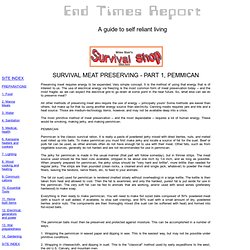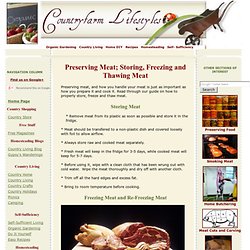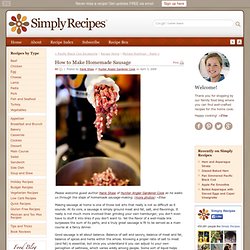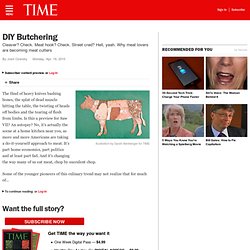Butchering and Meat Preservation
> Ianrawlings
How to Preserve Meat With Salt. Preserving Meat on the Frontier.
I magine living in an era when there is no refrigeration.

None at all. If you live in a town you might get ice delivered to your house every week or so during the spring, fall, and winter, about twice or three times a week during a Southern, Texas , or Southwestern summer. However, if you live in the country, you're not going to have ice except as a special treat a few times a year. Of course, if the creek nearest your property freezes over during the winter-thick ice, not thin-you might go down and saw chunks of ice out of the creek. Unless you've got well-insulated underground storage for it, it's not going to last much past the middle of June.
How to Make Sausages at Home. Storing_meat_1. Preserving meat requires energy to be expended.

Very simple concept. It is the method of using that energy that is of interest to us. The use of electrical energy via freezing is the most common form of meat preservation today -- and the most fragile, as we can expect the electrical grid to go down at some point in the near future.
Sausage Making – Instructions for Sausage Making at Home. Home sausage making is easy and delicious, and opens the door to virtually unlimited possibilities in terms of the type of meat and seasonings you use.

I recently sat in on a sausage making class at kitchenware store Las Cosas in Santa Fe, N.M. Led by veteran sausagemakers (and store staffers) Dick Faller and Jean Lamuniere, a class of aspiring sausage-makers learned how to grind the meat, season the mixture, stuff the sausage into casings, and, finally, cook the sausage. If you don't have the opportunity to take a class like this, never fear.
I've outlined all the steps on making sausage in this easy tutorial.
Preserving Meat; Storing, Freezing and Thawing Meat. Preserving meat, and how you handle your meat is just as important as how you prepare it and cook it.

Read through our guide on how to properly store, freeze and thaw meat. Storing Meat * Remove meat from its plastic as soon as possible and store it in the fridge. * Meat should be transfered to a non-plastic dish and covered loosely with foil to allow airflow. * Always store raw and cooked meat separately. * Fresh meat will keep in the fridge for 3-5 days, while cooked meat will keep for 5-7 days. * Before using it, wipe with a clean cloth that has been wrung out with cold water.
.
* Trim off all the hard edges and excess fat. * Bring to room temperature before cooking.
How to Make Homemade Sausage Recipe. Please welcome guest author Hank Shaw of Hunter Angler Gardener Cook as he walks us through the steps of homemade sausage-making.

(more photos) ~Elise Making sausage at home is one of those lost arts that really is not so difficult as it sounds.
Butchering Techniques. Steers are most commonly slaughtered for beef.

A steer is a castrated male beef cow. The steer is sedated before the jugular vein is cut. The animal is then hung from a hook, the skin is removed and the internal organs are taken out. Many groups prefer to retain all parts of the cow for use in various dishes. Hooves can be made into gelatin while tails can be used to flavor a bean dish.
Home Butchering. Pressyeta recipe ½ hog’s head (about 5 lbs) 2 lbs. lean pork 2-2 ½ lbs. veal shoulder 1 large piece hog’s rind To every quart of water: 1 T salt 5 white peppercorns 1-2 cloves ½ bay leaf 2-3 slices onion ½ carrot Clean the hog’s head, and singe off hair and bristles, clean teeth with stiff brush, and cut off ears.

Soak in cold water 6-12 hours. Changing water if necessary.
DIY Butchering. The thud of heavy knives bashing bones, the splat of dead muscle hitting the table, the twisting of heads off bodies and the tearing of flesh from limbs.

Is this a preview for Saw VII? An autopsy? No, it's actually the scene at a home kitchen near you, as more and more Americans are taking a do-it-yourself approach to meat. It's part home economics, part politics and at least part fad.
Build A Home Butcher Shop. James Raiswell Share on Facebook Share on Twitter.

Slaughtering and Butchering by Dynah Geissal Issue #23. Fall is butchering time, a period of joy in the harvest of the year's work and of sadness that the lives of your beautiful, healthy animals have come to an end.

On this occasion the animals should be treated with the same kindness and respect with which they were treated during their lives. Good farmers raise their animals free from fear, anxiety and stress.
Step-by-Step Home Butchering for Sheep, Lambs and Goats with Images. How To: Gut, Skin & Field Dress. Meat preservation. Slices of beef in a box. The invention of such processes can be traced back to antiquity, and although some come from 18th and 19th century research, the latest discoveries concerning meat preservation stem from nuclear physics and biochemistry.
The preservation of the meat has always been a method to prevent against famine, but has also acquired a political and economic dimension in the growth of the human population. In developed countries, this conservation depends largely upon the food industry rather than individuals.
Dried meat. Dried meat is a feature of many cuisines around the world.
Examples include: See also[edit] References[edit]
Manual on simple methods of meat preservation. The designations employed and the presentation of material in this publication do not imply the expression of any opinion whatsoever on the part of the Food and Agriculture Organization of the United Nations concerning the legal status of any country, territory, city or area or of its authorities, or concerning the delimitation of its frontiers or boundaries. All rights reserved. No part of this publication may be reproduced, stored in a retrieval system, or transmitted in any form or by any means, electronic, mechanical, photocopying or otherwise, without the prior permission of the copyright owner.
Potted Meats. Potted meat is a method for preserving meat.
The meat is cooked, placed hot in a pot, tightly packed to exclude air, and then covered with hot fat.
Jerky. There are many products in the marketplace which are sold as jerky which consist of highly processed, chopped and formed meat, rather than traditional sliced, whole-muscle meat. These products may contain more fat, but moisture content, like the whole-muscle product, must meet a 0.75 to 1 moisture to protein ratio in the US.[4] Chemical preservatives can be used to prevent oxidative spoilage, but the moisture to protein ratio prevents microbial spoilage by low water activity.
Many jerky products are very high in sugar and are therefore very sweet, unlike biltong, which rarely contains added sugars.
How to Brine Meat. How to Make Beef Jerky: 7 steps (with pictures)
Edit Article. Smoking (cooking)
Pork ribs being smoked Smoked beef sandwich. Jerky Recipes. I ask you do you want jerky?
How to Smoke Meat. Pemmican. Chokeberries (Aronia prunifolia), sometimes added to pemmican Pemmican is a concentrated mixture of fat and protein used as a nutritious food.
Smoked meat. 17th Century diagram for a smoke house for producing smoked meat Smoked meat is a method of preparing red meat (and fish) which originates in prehistory.
Its purpose is to preserve these protein-rich foods, which would otherwise spoil quickly, for long periods.
Pemmican Recipe. Smoking Meat - The Complete How to Smoke Meat Guide.










